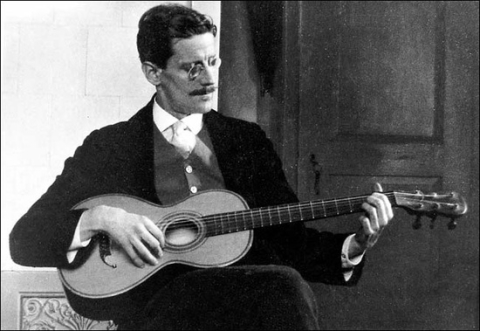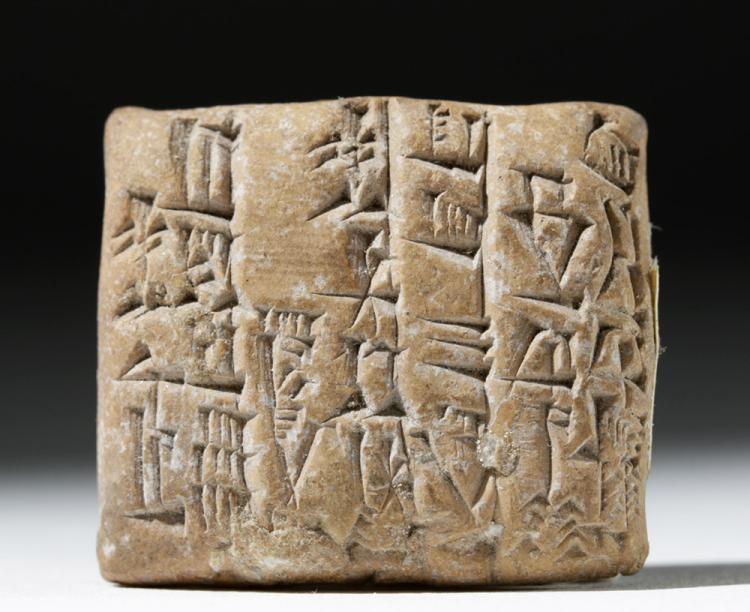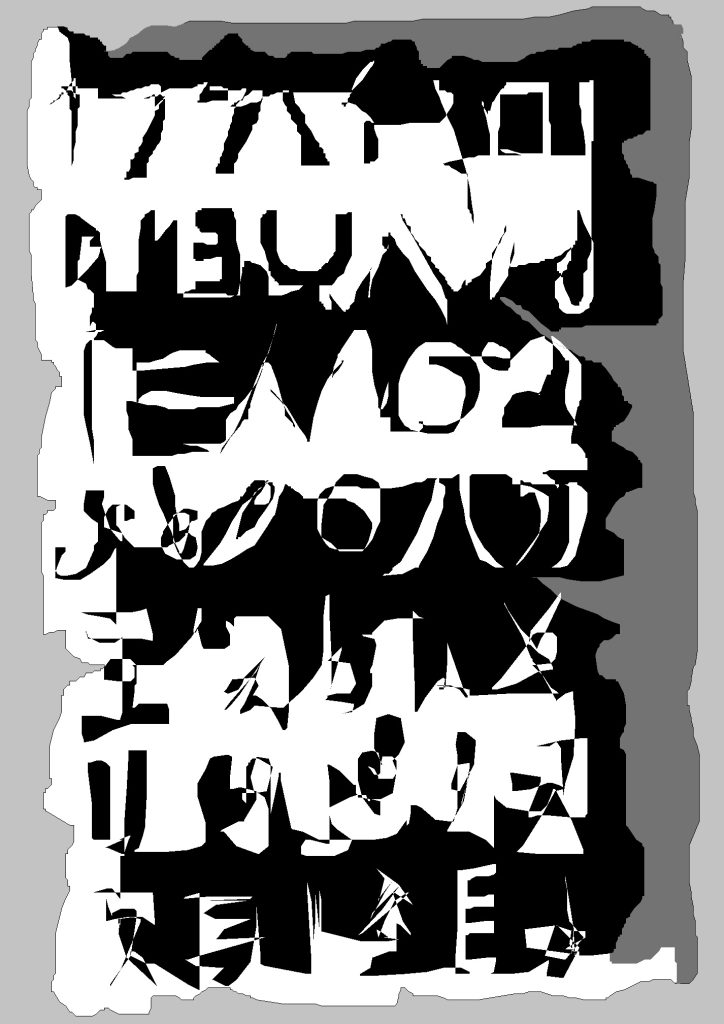
Ben Watson writes about Finnegans Wake, the “incomprehensible” final book by James Joyce which he’s been poring over for five decades …
Finnegans Wake is an experience, it’s not something “difficult” to be decoded by better brains than yours. I don’t read it with any more “comprehension” today than I did age 14, when I took it off the school library shelf and had a look. An older brother had been disparaging my precocity by saying “He’ll be reading James Joyce next”. I asked my mum who this James Joyce was: “Oh, a very difficult writer, also rather obscene”. Naturally, the very next day I ran to the school library at break, and looked up Joyce in the card index. Finnegans Wake was the first volume that came to hand. I read the first page, skipped through and loved it straight away! It resembled other things I loved – Lewis Carroll, The Beano, Molesworth, Afferbeck Lauder’s Fraffly – an explosion of rule-breaking craziness, naughtiness, anti-decorum. Sure, there are lines where I can now “explain” some pun or reference, but these have nothing to do with the book’s main pleasure: an outpouring of verbal energy which thunders and farts like a human body, like an emergent bewebbed cosmos, like a throbbing itching brain. You must suspend the quick flattery of your left hemisphere granted you by smart cultural products, and groove to the archaic and natural rhythms of the rhetoric – a flow never broken, unbrookable – which always adheres enough to the cadences and etymologies of the English language, whether derived from tavern or sewer, study, bedroom or church, to be read aloud with conviction. We might not know what’s it’s saying, but we know what these sounds mean. I never met a musical person who couldn’t enjoy a sentence of the Wake.
This sentence should be sprayed on the wall in letters of gold for all Wake readers:
“No man can live the moral part of his psychical (soul) life on the truth of another any more than he can live his physical (body) life on the meals of another. Every one must have his own truths, even as he must have his own meals.” Bishop William Montgomery Brown, Communism and Christianism: Analysed and Contrasted from the Marxian and Darwinian Points of View (self-published in Galion, Ohio from 1920 to the Bishop’s death in 1937; 14th edition, 1932, pp. 46-47; copies rare because they are seized and burned by the Church of America).
“Incomprehensible”, yes. But each time you look at Finnegans Wake, you discover something … On this occasion, it was the absolute bankruptcy of post-structuralist Theory as it is known and taught in the Humanities today. Proof that Theory has clouded the minds of a generation of intellectuals, no longer able to look at what is immediately in front of them. You can’t “read” (=skim) the Wake, you have to slow down … and look. There is no ideological preparation that can help, and the text confirms no “theoretical” positions. It is anti-religion in active manifestation!
I was excited with a paragraph on pages 123-124, because I’d been thinking about scores, records and music. The weird way a spatial construct on a page or on a piece of revolving plastic can dictate a piece of time. A passage in the Wake connected this space-time relationship to the oldest known “writing” we know, Mesopotamian clay tablets …

Here’s the passage. Folks, slow down, peer at this thing. It’s ART. It requires your attention and it rewards your attention … as no published prose in English since the King James Bible, Milton, Blake or Capital. And of course, it’s talking about itself, as it ceaselessly does:

The original document was in what is known as Hanno O’Nonhanno’s unbrookable script, that is to say, it showed no signs of punctuation of any sort. Yet on holding the verso against a lit rush this new book of Morses responded most remarkably to the silent query of our world’s oldest light and its recto let out the piquant fact that it was but pierced butnot punctured (in the university sense of the term) by numerous stabs and foliated gashes made by a pronged instrument. These paper wounds, four in type, were gradually and correctly understood to mean stop, please stop, do please stop, and O do please stop respectively, and following up their one true clue, the circumflexuous wall of a singleminded men’s asylum, accentuated by bi tso fb rok engl a ssan dspl itch ina, — Yard inquiries pointed out – that they ad bîn “provoked” ay ˄ fork, of à grave Brofèsor; àth é’s Brèak — fast — table; ; acùtely profèššionally piquéd, to=introdùce a notion of time [ùpon à plane (?) sù ’ ’ fàç’e’] by pùnct! ingh oles (sic) in iSpace?! James Joyce, Finnegans Wake (1922-1939, pp. 123-124).
What so many commentaries on the Wake miss (I except Len Platt’s wonderful introduction to the cheap paperback published by Wordsworth Editions) is how scurrilous, parodic and angry so much of it is. This is a portrait of ridiculous over-educated buffoon – a Slavoj Zizek – stabbing his toast with a fork in order to explain Space-Time. It evinces the same scepticism about world pictures which activated Frank Zappa and Philip K. Dick. Finnegans Wake is not High Art in the vein of T. S. Eliot and Ezra Pound, it’s lowdown smut, an explosion of ribaldry versus privilege, as countercultural as R. Crumb – and similarly grotesque, obscene and hilarious.
And here’s a detail that escaped my attention for fifty years: just dig the way “fact” becomes a misprint of “fart” in Joyce’s composition: “Yet on holding the verso against a lit rush … its recto let out the piquant fact …“. This low view of “fact” chimes with Joyce’s attack on the closed minds of contemporary science graduates in the talk on William Blake he delivered in Trieste. The Wake adheres to the art politics of Blake in his preface to Milton: will everyone please stop serving the rich!
Rouze up O Young Men of the New Age! Set your foreheads against
lo the ignorant Hirelings! For we have Hirelings in the Camp, the Court, &
the University: who would if they could for ever depress Mental & prolong
Corporeal War. Painters! on you I call. Sculptors! Architects! Suffer not the fashionable Fools to depress your powers by the prices they pretend to give for contemptible works or the expensive advertizing boasts that they make of such works.
Joyce’s sexual politics may be a little out of date, since we now have plenty of female “Brofèsors”, yet the accusation of spiritual miscomprehension by those who are paid to look at the letter remains. Joyce’s charge that there is a gender component in the replacement of wisdom by competitive pedantry (the “singleminded men’s asylum“) compares to Sabine Hossenfelder’s magnificent YouTube tirades against “Theory of Everything” tyros like Eric Weinstein. The revolution in Paris of May ’68 began as a protest against the segregation of the sexes; Joyce was well aware that oppressive gender roles suit life-denying scientism.
But the really devastating outcome of looking at these lines arrived for me when, after I circulated them, a friend Googled the passage, and sent me a link to a post-structuralist commentary. Here were readers totally unaware that that it’s they who are under attack in these lines!
When she was thinking for herself, my friend supplied me with a real insight: the “bi tso fb rok engl a ssan dspl itch ina” atop the wall which surrounds the “singleminded men’s asylum” is something she remembered from her childhood in Lusaka, Zambia, and reminded me of my own childhood sighting of broken glass atop brick walls. Forget Lacan’s mirror stage – a theoretical figure which no-one actually remembers – this sight broke us out of the protected bubble of childhood, and we realised how cruel the world can be, especially when protecting private property. Do they really want to cut me up for wanting to see what’s on the other side? Burglars must be really desperate to risk climbing over that!
But to the reason for this Substack item: the abolute bankruptcy of the post-structuralist tradition for explaining anything, especially revolutionary art. Viz: Lydia H. Liu’s The Probability of Sense in the Hypermnesiac Machine (Presses Universitaires de Paris Nanterre, 2017). The Internet promises access to all knowledge, but can quickly become a Bible of readymade answers which block creative thought, which invariably stems from personal attention to specifics. Darwin could never have devised the theory of evolution if all those nineteenth-century vicars hadn’t been collecting fossils on the beach as examples of God’s handywork.
“The Hypermnesiac Machine” is Lydia Liu’s coinage to describe the Standard English and computerization via information theory which accompanied technological breakthroughs in the Anglo-American war effort 1939-1945, and which kept up its pace in the following decades due to the USA’s perceived need to battle Communism, drugs, Islam, terrorism etc. Like Derrida and Lacan, the two post-structuralists she uses to gloss the Wake, Liu fails to see that Joyce was writing against capitalism, war and its “scientific” alienations. She uses “bi tso fb rok engl a ssan dsp itch ina” as a synecdoche of the whole book and Joyce’s method, comparing it to Claude Shannon’s conceptualization of the space as the 27th letter in the alphabet, which allowed development of the ASCII code and use of words in computing. Impressive sounding enough. But I can’t think of anywhere else in Finnegans Wake where a conventional piece of English is dismembered in this particular way! The outburst of diacritics in the same paragraph, taken by Liu as exemplary, is also unique. As a critic of the book, Liu is talking nonsense.
As usual, Derrida presides over this inability to respond to what’s there, this raid on the material to supply grist to Theory. Liu uses Derrida to generalize/moralise Joyce’s method into the gruesomely predictable postmodern sermon – difference is good, disruption is necessary, linear thought is wicked, we must all be pious liberals “subverting power” in our art – whereas, like Marx, Joyce found ideas in the materials he dealt with, he was not applying a preconceived method or ideology. Every time I look at the Wake, I get new ideas. Every time I read the Wake to someone, or get them to read a passage, I discover new things. Joyce breaks up the words of “bits of broken glass and split china”, not in order to point out that parsing words is dependent on the spaces between them (one can examine his hundred-letter “thunder” words and still make out words inside them), but so that his row of letters resembles shards of glass and china set in cement.
Liu quotes Derrida saying: “This Anglo-Saxon commerce, these exchanges of a piece of merchandise (ware) in two languages, must pass through acts of writing. The event is linked to the spacing of its archive and would not take place without it, without being put into letters and pages. Erase the typeface, mute the graphic percussion, subordinate the spacing, that is, the divisibility of the letter, and you would again reappropriate Finnegans Wake into a monolingualism, or at least subjugate it to the hegemony of a single language.” (Derrida 1984, 147)”
Derrida’s vaunting of the written word makes him a household god for those make a living by interpreting words. Joyce used to read the Wake aloud, but this is interdit in the Derridean ideology, because making the page invisible reduces it to a monologue. Not so! If you read the Wake out loud it does NOT become Standard English, it’s a new tongue … like an English-speaker hearing Cambrian dialect today, we seem to be hearing from some prenational hinterland. Alexandre Kojève defused Hegel’s “German” dialectic for France’s Cartesian establishment. Likewise, Derrida’s insistence on the written rather than the spoken bespeaks a reactionary politics: the complexity of written French compared to spoken French is all about honouring grammatical relations which are inaudible today – i.e. dead – so only available to the schooled, a badge of distinction. It is the very opposite of Valentin Volosinov’s Marxist linguistics, which begin with the spoken, the living, the “concrete utterance”.
Liu asserts: “By manipulating typefaces, graphic forms, spacing, and an exhaustive variety of written signs, Joyce constructs a vast network of writing that interlinks up to allegedly 40 languages and stores numerous historical archives.” This is Jorge Luis Borges – a vision of an impossible total library – not the Wake, which stimulates the tongue to activity.
Liu makes simple blunders: “Lewis Carroll’s ‘Jabberwocky” verse in the novel Through the Looking-Glass (1871). is one of the best-known nonsense poems written in the English language, relying predominantly on the play of sounds.” Only the first and last verses! “Jabberwocky” is a monster-slaying hero tale.
“Joyce’s nonsense word “iSpace”—coined long before the invention of the iPhone and the iPad—anticipated Shannon’s development of Printed English by assuming a radical rupture between writing and speech. It matters little if one can spell or pronounce this nonsense word, for our speech cannot reproduce the ideographic image of iSpace in sound nor can it assign a linguistic meaning to it.”
This is “the French Joyce”, a raid on the Wake to buttress post-structuralist preconceptions. There are pointed “unpronounceable”/visual elements in the Wake, sure, but no “radical rupture” with speech. The thing invites performance! Also, because of the iPhone and iPad, you can read out “iSpace” now, and most people will have a clear idea of what word you’re reading, even down to the camel case. The Derridean effect – like Slavoj Zizek finding the “objet petit a” in every movie he sees – is to reduce everything to the same, to blot out specifics, to hide reality, to mask exploitation, to fend off critique and politics. To deny me here, you there. Post-structuralism blinds people to what’s actually there. Like a Zizek YouTube, the “Brofèsor; àth é’s Brèak — fast — table” is funny, but only because he’s patently an idiot.
Liu then turns to Jacques Lacan on the Wake. Of course! The next tainted saint in the Canon. Opportunist vultures ripping up the corpse of a modernism designed for REVOLUTION! My better half berates me for going on too long about the evils of post-structuralism and postmodernism (“everyone in academia has forgotten about it now, it’s just your personal trauma, a fashion that denied you – neanderthal Marxist – a job in the Humanities in the 80s”), but if you Google my favourite things today – the Wake, Dada, Free Improvisation, sound poetry – that’s what you find. It’s like looking for Jesus … and all you can find is the Roman Catholic Church!
More Liu: “‘The real’, Lacan wrote elsewhere, ‘is completely denuded of sens [meaning]. We can be satisfied, we can be sure that we are dealing with something of the réel [the real] only when it no longer has any sens whatsoever. It has no sens because it is not with mots [words] that we write the réel. It is with petites lettres [little letters].’ (my emphasis)”
This is hard (stupid?) Cartesianism – duality between spirit and matter – and utterly in opposition to Joyce’s dialectical holism. What a doleful effect this hopeless doctrine has had on a generation of intellectuals! A smug nihilism about practical action, a Platonic contempt for the lowly artisan. The precise opposite of Hegel’s translation of Christian values into a progressive secular rationality, Marx’s discovery of the working class, Bishop Brown and Martin Luther King’s ideas of popular resistance …
As usual in this zone, a profound-sounding “conclusion” which is actually utterly inconclusive, inert, equivocal and predictable, an “I looked into something and discovered what I already knew, i.e. what has been canonised as the thought of my time.” Post-structuralism is a New Catholicism, with its own roll-call of saints, its own pious shibboleths … Finnegans Wake was designed by Joyce to undo the “instrumental reason” which produces capitalism, marketing algorithms, automatic stock-broking and war … but for Liu and her authorities, it’s all the same thing. This is how Liu concludes: “At a fundamental level, the communication machine can process nothing—certainly not words, in spite of its word-processing reputation—but the petites lettres of Printed English. That which gets processed guarantees no more—and no less—sense than does the ‘iSpace’ of Finnegans Wake.”
On the contrary, Joyce’s “iSpace” puts us back in space – just where Newton and Einstein (and cluster bombs sold to Ukraine for purposes of profit) deny our subjectivity and the naive empathy of our species being! Like Free Improvisation, the Wake challenges authority, and asks listeners to supply their own interpretation, unleashing our personal memories and associations like a psychoanalysis or a Rorschach blot (but not costing us a fortune). It’s a bustling market, a busting farrago, a verbal storm, a rush, a dream … it works. Unlike, say, Gertrude Stein, who also ticks the postmodern boxes, but has next to no content and – like orchestral Minimalism or Evan Parker’s circular-breathing turn – stuns the mind rather than causing it to pay attention to what’s there.
Out To Lunch, Somers Town 17-viii-2023
PS If you wish to follow up OTL’s polemic, find Geert Lernout’s The French Joyce (University of Michigan Press, 1992) comparable in polemical power to the Sokal/Bricmont hoax in revealing the Kojève/Derrida/Lacan/Foucault/Deleuze lineage as woeful intellectual charlatanism.
(Ben Watson presents Late Lunch with Out to Lunch weekly on ResonanceFM 104.4 )
(This article has been corrected to say that Lusaka is the capital of Zambia, NOT Gambia as first stated)

“Lusaka, Gambia”
don’t you mean Zambia? A slipped character in a piece about FW….
Thanks for that. Corrected.